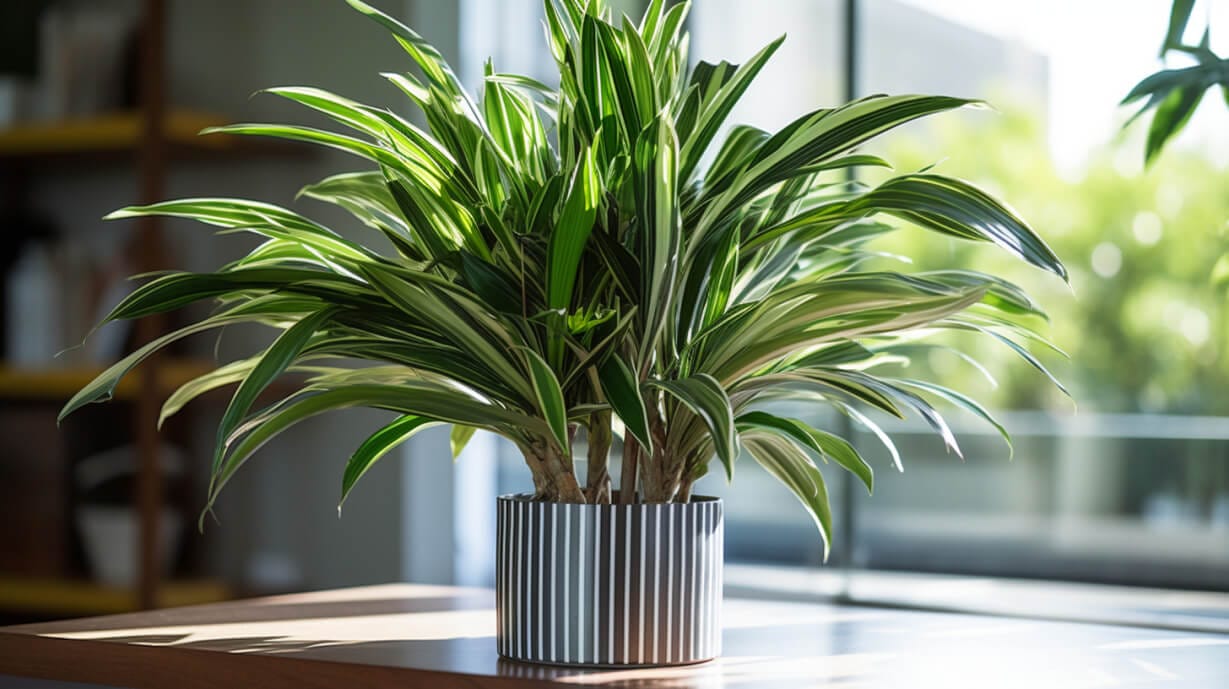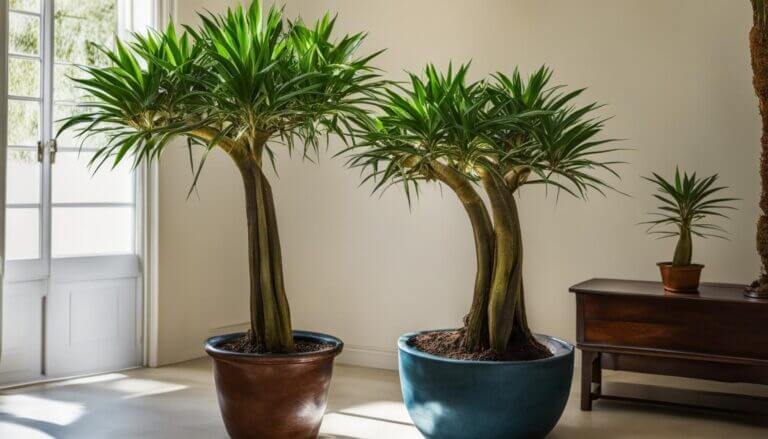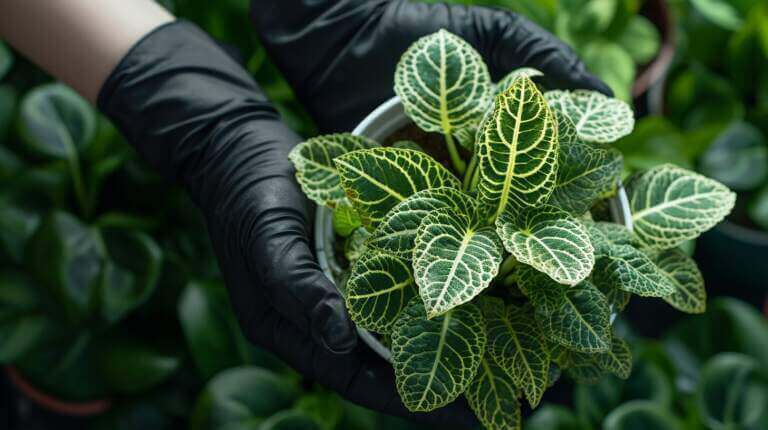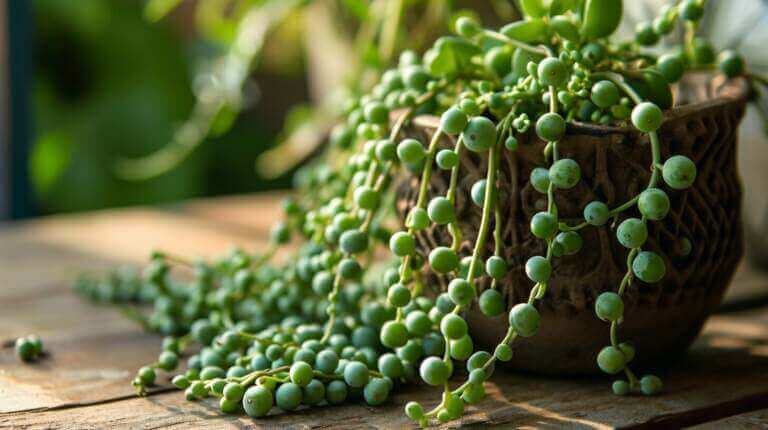Pruning an overgrown dracaena indoor plant is essential to control its height and maintain its appearance. If your dracaena has grown too tall and is taking up too much space, it’s important to know how to prune it safely and effectively. In this section, I will provide step-by-step instructions and tips for pruning an overgrown dracaena plant, ensuring that you can maintain its height while promoting healthy growth.
Key Takeaways:
- Pruning an overgrown dracaena plant helps to control its height and maintain its appearance.
- Peel off any brown or yellow areas on the leaves and cut them to resemble the others for a uniform look.
- Remove damaged leaves growing out of the base of the cane.
- Consider cutting off a stem to encourage upper growth or maintain the plant’s form.
- Create a compact, bushy shape by cutting the top of the main stem.
- Prune dracaenas in the spring before the growth period and again in the late summer after it is over.
- Always use clean, sharp tools like a knife or garden shears when pruning your dracaena.
Understanding the Dracaena Plant and Its Growth Habits
Before diving into the pruning process, it’s important to understand the dracaena plant and how it grows. Dracaenas are popular houseplants known for their striking foliage and easy care. These plants belong to the Asparagaceae family and are native to Africa and Asia. With their long, arching leaves and sturdy canes, they can add a touch of tropical elegance to any indoor space.
Dracaenas are known for their slow growth and can reach heights of up to six feet indoors. However, if left unpruned, they can become overgrown, making them look untidy and taking up valuable space in your home. Pruning is essential to control the height of the plant and maintain its appearance.
Dracaenas can become overgrown due to their innate ability to produce new leaves from the top, which causes the lower leaves to gradually wither and die. Pruning helps create a balanced and aesthetically pleasing plant.
Understanding the growth habits of dracaenas is crucial for effective pruning. These plants have a strong apical dominance, meaning that the main stem or cane grows upward, while the side branches grow more slowly. The apical dominance is responsible for the vertical growth of the dracaena. Pruning the top of the main stem encourages branching and creates a bushier appearance.
Table: Dracaena Growth Habits
| Growth Habit | Description |
|---|---|
| Apical Dominance | Main stem grows upward, side branches grow more slowly |
| Basal Shoots | Plant produces new shoots from the base of the cane |
| Leaf Growth | Leaves grow from the top of the plant, causing lower leaves to wither |
By understanding the growth habits of your dracaena plant, you can effectively prune it to maintain its shape and size. In the following sections, we will explore when and how to prune an overgrown dracaena plant, step-by-step pruning techniques, and tips for pruning different dracaena varieties.
When and How to Prune an Overgrown Dracaena Plant
Pruning an overgrown dracaena requires careful timing and proper techniques to ensure successful growth. By following the right steps, you can control the height of your plant and maintain its overall health. Here are some pruning tips to help you achieve the desired results:
- Prune your dracaena in the spring before it enters the growth period. This timing allows the plant to recover and regrow during its active season.
- Trim the damaged or discolored leaves by peeling them off gently with your hands or using gardening scissors. This will improve the appearance of the plant and promote healthier growth.
- If there are any leaves growing out of the base of the cane, snip them off to maintain a tidy and compact shape.
- To encourage upper growth or correct any irregularities, remove a stem that is growing out of form.
- To create a bushier appearance, cut the top of the main stem. This will stimulate the growth of new shoots and result in a more compact plant.
- Prune your dracaena again in late summer after its growth period is over. This secondary pruning will help maintain the desired height and shape.
- Always use clean and sharp tools, such as a knife or garden shears, to minimize the risk of infection and ensure clean cuts.
Remember to take your time and assess your plant’s growth pattern before making any cuts. Each dracaena variety may have specific requirements, so make sure to research or consult a gardening expert for more detailed instructions. Proper pruning techniques and timing will help you keep your dracaena healthy and thriving.
Summary
Pruning an overgrown dracaena plant requires careful timing and proper techniques to ensure successful growth. Start by trimming off damaged and discolored leaves, and remove any leaves growing out of the base of the cane. To encourage upper growth or create a bushier shape, consider removing a stem or cutting the top of the main stem. Prune your dracaena in the spring before the growth period and again in late summer after it’s over. Always use clean and sharp tools when pruning, and take into account the specific requirements of your dracaena variety. Following these steps will help you maintain a healthy and aesthetically pleasing dracaena plant.
| Pruning Tips for Overgrown Dracaena Plants |
|---|
| Prune in the spring before the growth period |
| Trim damaged or discolored leaves |
| Remove leaves growing out of the base of the cane |
| Remove a stem to encourage upper growth |
| Cut the top of the main stem for a bushier shape |
| Prune again in late summer after growth period |
| Use clean and sharp tools for pruning |
Step-by-Step Guide to Pruning an Overgrown Dracaena Plant
Follow these step-by-step instructions to effectively prune an overgrown dracaena and maintain its health and appearance:
- Start by inspecting the plant for any brown or yellow areas on the leaves. Gently peel off these damaged portions with your hands or use gardening scissors to trim them away. This will help improve the overall aesthetic of the plant.
- To create a more uniform look, cut the remaining leaves to resemble the others. Trimming off any excessively long or misshapen leaves will give the dracaena a neater appearance.
- Next, examine the base of the plant for any damaged leaves that may be growing out of the sides. Snip these off at the base using clean pruning shears. Removing these damaged leaves will promote healthier growth.
- If you notice stems growing out of form or in undesirable directions, selectively remove them. Snipping off these wayward stems will help maintain the desired shape and structure of the dracaena.
- To encourage a compact and bushy growth habit, cut the top of the main stem. This will stimulate branching and result in a more aesthetically pleasing appearance.
- Timing is crucial when pruning dracaena plants. It is best to prune them in the spring before they enter their growth period. This will allow the plant to recover and promote healthy new growth.
- For additional pruning, consider trimming the dracaena again in late summer once their growth period is over. This will help maintain the desired height and shape throughout the year.
- When pruning, always use a clean, sharp knife or garden shears. This will prevent damage and reduce the risk of introducing infections or diseases to the plant.
By following these step-by-step instructions, you’ll be able to effectively prune an overgrown dracaena plant, ensuring its health and maintaining its appearance.
Tips for Pruning Different Dracaena Varieties
Depending on the specific variety of dracaena you have, there may be additional considerations and techniques for pruning. Listed below are some general pruning tips for different dracaena varieties:
- Dracaena Marginata: This variety of dracaena is known for its long, thin leaves with red edges. To maintain its height and shape, carefully trim off any dead or yellow leaves. You can also prune the stem to encourage branching and a fuller appearance.
- Dracaena Fragrans: Also known as the corn plant, this variety has broad, arching leaves. Regularly remove any discolored or damaged leaves to keep the plant healthy. Pruning the top of the stem can promote bushier growth.
- Dracaena Reflexa: With its twisted, ribbon-like leaves, this variety requires gentle pruning. Trim back any dead or discolored leaves, as well as any stems growing out of shape. Pruning the top can help create a more compact and attractive appearance.
- Dracaena Sanderiana: Commonly known as lucky bamboo, this variety is often grown in water. If you notice any decaying or yellowing leaves, carefully remove them. You can also trim the stalks to achieve your desired height and shape.
To ensure successful pruning, use a clean, sharp knife or garden shears. This will minimize the risk of damaging the plant and help promote healthy regrowth. Remember to prune your dracaena plants in the spring before their growth period begins, and again in late summer after their growth period is over.
By following these tips and considering the specific needs of your dracaena variety, you can maintain a well-shaped and healthy plant for years to come.
| Variety | Pruning Tips |
|---|---|
| Dracaena Marginata | Carefully trim off dead or yellow leaves. Prune stem to encourage branching. |
| Dracaena Fragrans | Remove discolored or damaged leaves. Prune top of stem for bushier growth. |
| Dracaena Reflexa | Trim back dead or discolored leaves. Prune stems growing out of shape. Prune top for compact appearance. |
| Dracaena Sanderiana | Remove decaying or yellowing leaves. Trim stalks to desired height and shape. |
Propagating Dracaena from Pruned Cuttings
Pruning your dracaena not only helps control its height but also provides an opportunity to propagate new plants. By following the proper techniques, you can easily create new dracaena plants from pruned cuttings. Here’s a step-by-step guide to propagating dracaena:
- Start by selecting a healthy stem that is at least 6 inches long. Look for a stem with no signs of disease or damage.
- Using a clean, sharp knife or garden shears, make a clean cut just below a node (the point on the stem where leaves or branches emerge).
- Remove the lower leaves from the cutting, leaving a few leaves at the top intact. This will help the cutting retain moisture and continue to grow.
- Fill a small pot with a well-draining potting mix. You can also use a mixture of perlite and peat moss.
- Make a small hole in the potting mix and insert the cutting, making sure that at least one node is below the soil surface.
- Gently press the soil around the cutting to secure it in place.
- Water the cutting thoroughly and place the pot in a warm, bright location. Avoid direct sunlight, as it can scorch the cutting.
- Maintain the moisture level in the soil by watering regularly, but be careful not to overwater.
- Within a few weeks, the cutting should begin to develop new roots. You can gently tug on the cutting to check for root growth.
- Once the cutting has established roots, you can transplant it to a larger pot or directly into the garden.
Propagating dracaena from pruned cuttings is a rewarding and cost-effective way to expand your collection of these beautiful plants. With a little patience and care, you can enjoy the satisfaction of growing new dracaenas from your own cuttings.
Table: Propagating Dracaena from Pruned Cuttings
| Step | Description |
|---|---|
| 1 | Select a healthy stem |
| 2 | Cut just below a node |
| 3 | Remove lower leaves |
| 4 | Fill a small pot with potting mix |
| 5 | Insert the cutting into the potting mix |
| 6 | Press soil around the cutting |
| 7 | Water thoroughly and place in a bright location |
| 8 | Maintain moisture level in the soil |
| 9 | Check for root growth |
| 10 | Transplant the cutting |
With these simple steps and a little care, you can successfully propagate dracaena from pruned cuttings and enjoy the beauty of these plants in multiple locations. Happy propagating!
Maintenance Tips for a Healthy Dracaena Plant
In addition to pruning, regular maintenance is crucial for keeping your dracaena plant healthy and vibrant. By following these maintenance tips, you can ensure your plant thrives and remains a beautiful addition to your home or office environment.
First and foremost, ensure your dracaena receives the right amount of water. Overwatering can lead to root rot, while underwatering can cause dehydration. Aim to keep the soil consistently moist, but not soggy. Check the moisture level by sticking your finger about an inch into the soil; if it feels dry, it’s time to water.
Fertilizing your plant is also important to provide it with the nutrients it needs. Use a balanced, water-soluble fertilizer during the growing season, following the manufacturer’s instructions. Be cautious not to over-fertilize, as this can damage the plant.
In addition to watering and fertilizing, your dracaena will benefit from regular cleaning. Dust the leaves with a soft, damp cloth or sponge to remove any accumulated dirt or grime. This not only keeps your plant looking its best but also ensures proper nutrient absorption.
Lastly, keep an eye out for common pests that may affect your dracaena plant, such as spider mites or mealybugs. If you notice any signs of infestation, promptly address the issue with an appropriate insecticide or by using natural pest control methods.
By following these maintenance tips, you can enjoy a healthy, thriving dracaena plant that adds beauty and greenery to your space.
FAQ
How do I prune a dracaena marginata house plants?
To prune an overgrown dracaena plant, start by peeling off any brown or yellow areas on the leaves with your hands or gardening scissors. Then, cut the leaves to resemble the others for a uniform look. Snip off any damaged leaves growing out of the base of the cane and remove a stem if it’s growing out of form or to encourage upper growth. Finally, cut the top of the main stem to create a compact, bushy shape.
When is the best time to prune an overgrown dracaena plant?
It’s best to prune an overgrown dracaena plant is in the spring before it hits the growth period. Pruning during this time will allow the plant to recover and promote healthy growth. Additionally, you can also prune the plant again in late summer after its growth period is over to maintain its shape.
What tools should I use to prune my madagascar dragon tree?
It is recommended to use a clean, sharp knife or garden shears when pruning your dracaena. This will ensure clean cuts and minimize damage to the plant.
Can I propagate new dracaena plants from pruned cuttings?
Yes, you can propagate new dracaena plants from pruned cuttings. Take a stem cutting from the mother plant and place it in water or a well-draining potting mix. Keep the cutting in a warm and humid environment until it develops roots. Once rooted, you can transfer it to a pot with a suitable growing medium and care for it as a new plant.
What are some maintenance tips for a healthy dracaena plant?
To keep your dracaena plant healthy, it is important to provide it with proper care. This includes watering the plant when the top inch of the soil feels dry, avoiding overwatering or allowing the plant to sit in standing water. Additionally, dracaenas benefit from regular fertilization using a balanced houseplant fertilizer. Finally, ensure that the plant is placed in a well-lit area, but away from direct sunlight, as excessive light can cause leaf burn.







